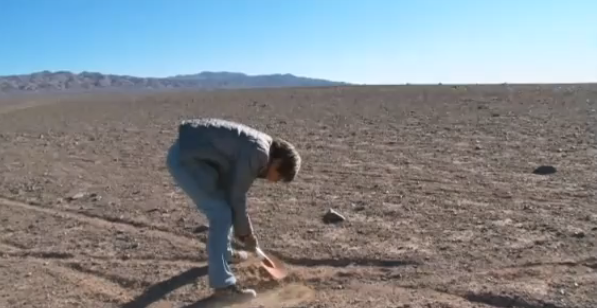Nostalgia for the light
“There is no present, only the past,” an astronomer says in Patricio Guzman’s “Nostalgia for the Light.” He goes on to explain that as both light and sound take time to travel, by the time he hears the interviewer’s question in this documentary—if a film so profound can be called a documentary—or perceives his features at any given time, both voice and face as they look and sound in that nanosecond are already in the past. The Chilean director who, for the last forty years, has never stopped reflecting on his country’s history, gives us not only a stunning synthesis of that history but a metaphysical view of what it means to be human, of our origins and those of the planet we inhabit.
Filmed before the recent miners’ ordeal in the Atacama desert of Chile which spans over 40,000 square miles and is the driest place on earth, “Nostalgia for the Light” follows three tracks that are really one and the same. The first and most spectacular is the observatory, composed of any number of gigantic white structures built by international astronomers and holding the largest telescopes and the most advanced technology for studying the stars, the galaxies, and our universe as a whole. The air is so pure and so devoid of humidity in Atacama, the sky so clear and light pollution at night so minimal that scientists can indulge in the most rewarding star-gazing and come up with extraordinary insight about where it all comes from.
The perspectives are almost frightening, as when we hear that the combined strength of the advanced radio frequencies will allow to hear the stars’ and the planets movements all the way to the Big Bang, almost fourteen billion years ago!
The second track is that of archeologists who study rock drawings and other traces of the pre-Columbian peoples who lived in the area, going back to between 10,000 and 4,000 years. Everything has been perfectly preserved in the dry soil, including mummies that still have their hair and the colorful garments they died in.
The third track tells a story of almost unbearable desolation. Under Pinochet, the benevolent and aristocratic general who overthrew Salvador Allende, had him assassinated, and then headed Chile from 1973 to 1990, tens of thousands of political dissenters or opponents of the loathsome junta were arrested, tortured, and killed. The victims were buried in mass graves in the Atacama desert, then dug up and their bones either thrown in the sea or dispersed in other parts of the desert. For decades, families of the disappeared or desaparecidos looked for what they could find of the remains. Now, only a handful of people are left of those hundreds, a handful that will not give up.
The women, their skins thickened and clawed by the passage of time and the unforgiving sun, armed with totally inadequate equipment—mainly what looks like toy shovels— trudge back day after day for what seems to be their only purpose in life: find a sliver of shin bone or a piece of skull that they can identify, through DNA, as having belonged to a loved one. Their dogged and doomed effort—akin to trying to empty the Pacific ocean with an eye-dropper— and their loneliness in the midst of that immensity truly wring the heart.
The discrepancy between the smallness of their task and that of the astronomers reaching out to the farthest galaxies—the search for answers regarding extinct civilizations, then political prisoners victims of an inhuman regime, and the unceasing activity in the skies above make for an incredible experience from which one emerges both vivified and torn.





